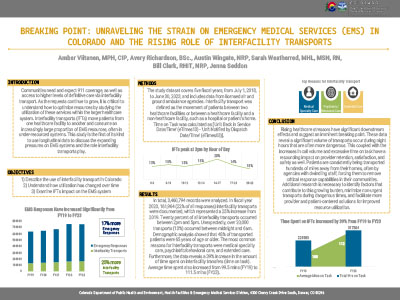ABSTRACTS
Breaking Point: Unraveling the Strain on EMS in Colorado and the Rising Role of Interfacility TransportAuthor: Amber Viitanen, Avery Richardson, Austin Wingate, Sarah Weatherred, Bill Clark, and Jenna Seddon | | Associate Authors:
Introduction: Reliance on emergency medical services (EMS) is increasing, with the Bureau of Labor Statistics projecting above-average growth for EMTs and paramedics. In Colorado, EMS demands are growing unsustainably, leading to staff burnout and recruitment issues. Understanding resource optimization is critical as service requests grow. Interfacility transports (IFTs), which move patients between healthcare facilities or between a healthcare facility and a non-healthcare facility, consume significant EMS resources. However, there is little research on the impact of IFTs on EMS systems. This study uses longitudinal data to discuss the pressures on EMS systems and the role of IFTs. Objectives: To describe IFT use in Colorado, understand utilization changes over time, and examine its impact on the EMS system. Methods: Data were extracted from electronic patient care reports (ePCRs) in the state-managed repository overseen by the Colorado Department of Public Health and Environment (CDPHE). The dataset covers five fiscal years (FY) from July 1, 2018, to June 30, 2023, including air and ground ambulance agencies. Duplicates were removed, and incidents outside Colorado were excluded. IFTs were defined using the NEMSIS element “Type of Service Requested” (eResponse05), with “time on task” calculated from “Unit Notified by Dispatch Date/Time” (eTimes03) to “'Unit Back in Service Date/Time” (eTimes13). Results: The analysis included 3,460,794 records, with 751,588 from FY 2023. In FY 2023, 161,964 (22%) IFTs were documented, mostly via ground ambulances, with nearly 8000 by air. IFTs peaked between 2 pm and 5 pm, with 13% occurring between midnight and 6 am. Nearly half (48%) of transported patients were 65 years or older. The number of IFTs increased by 25% from 2019 to 2023, with “time on task” increasing 39%, from 229,083 hours in 2019 to 317,504 hours in 2023. The average duration for ground IFTs also rose from 99.5 minutes in 2019 to 111.5 minutes in 2023. Conclusion: This study reveals increasing utilization of IFTs in an already underresourced EMS system, indicating significant impacts on provider retention and safety. Additional research is necessary to identify factors contributing to this burden and to optimize resource utilization.
|

